Touring Europe 2009
England, France, Switzerland, Austria, Hungary, Romania, Czech Republic, Germany
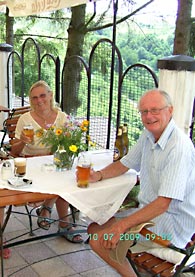 In May we were off once again to England and our campervan, for more travels in Europe. Some of Michael’s first-ever racing was at Brands Hatch, and we revisited the circuit for a major race meeting for historic cars at the invitation of the organisers. We camped there at a simple site (a field, basically) overlooking the circuit, which was fun, and were even able to share a glass of wine with a visiting Australian friend as we celebrated Norma’s 70th. After that, we enjoyed our regular stop at a beautiful part of the New Forest, enjoying the young wild horses and other local fauna wandering around the van. On our way to Dover we visited HMS Victory in Portsmouth and medieval Canterbury Cathedral, which we thought was a rather sombre building – compared, say, to Reims, the next one on our route.
In May we were off once again to England and our campervan, for more travels in Europe. Some of Michael’s first-ever racing was at Brands Hatch, and we revisited the circuit for a major race meeting for historic cars at the invitation of the organisers. We camped there at a simple site (a field, basically) overlooking the circuit, which was fun, and were even able to share a glass of wine with a visiting Australian friend as we celebrated Norma’s 70th. After that, we enjoyed our regular stop at a beautiful part of the New Forest, enjoying the young wild horses and other local fauna wandering around the van. On our way to Dover we visited HMS Victory in Portsmouth and medieval Canterbury Cathedral, which we thought was a rather sombre building – compared, say, to Reims, the next one on our route.
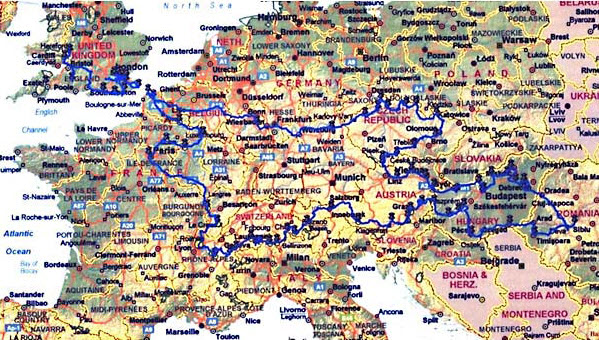
After crossing the Channel and driving via Reims and the Ardennes to Paris for our regular stay in the Bois de Boulogne and attendance at the FIA Institute motor sport safety research group meetings, we were away for another loop through Europe. This took us from France through Switzerland along the Swiss Alps, and so along to Austria and Hungary and thus to Romania. Returning westwards we went back through Hungary, and tracked through the Czech Republic and Germany on our way to England.
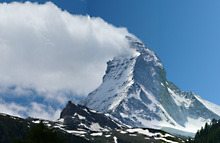 In the French Alps the weather (in mid-June) was still overcast, often wet, and always cool. But we fluked a gorgeous clear day for a ride to as high as you can go in cable cars, 3,842 metres at the summit of the Aiguille du Midi, with truly spectacular views of Mont Blanc and the many other snowy mountain ranges. In Switzerland we had days of mountain scenery and a visit to Zermatt and the Matterhorn. In the strong cold wind this
In the French Alps the weather (in mid-June) was still overcast, often wet, and always cool. But we fluked a gorgeous clear day for a ride to as high as you can go in cable cars, 3,842 metres at the summit of the Aiguille du Midi, with truly spectacular views of Mont Blanc and the many other snowy mountain ranges. In Switzerland we had days of mountain scenery and a visit to Zermatt and the Matterhorn. In the strong cold wind this 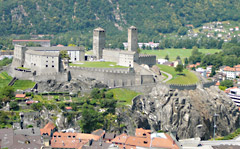 magnificent mountain was streaming clouds, a classic sight, viewed from the town and from the top of the lift at the summit of the Klein Matterhorn. Further east we dipped into Italy through the Simplon pass, mainly to visit the three castles of Bellinzona, one of the several UNESCO World Heritage sites on our route. We did think later that the merits of some of these sites is being devalued by their burgeoning number, as local authorities (who nominate them) seize upon their tourist potential. Bellinzona, however, certainly did not fit into this category, being a beautiful, ranging set of castles and other buildings in a strategically situated valley.
magnificent mountain was streaming clouds, a classic sight, viewed from the town and from the top of the lift at the summit of the Klein Matterhorn. Further east we dipped into Italy through the Simplon pass, mainly to visit the three castles of Bellinzona, one of the several UNESCO World Heritage sites on our route. We did think later that the merits of some of these sites is being devalued by their burgeoning number, as local authorities (who nominate them) seize upon their tourist potential. Bellinzona, however, certainly did not fit into this category, being a beautiful, ranging set of castles and other buildings in a strategically situated valley.
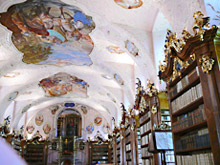 Back through eastern Switzerland and into Austria. The weather had not been brilliant at any time so far, but now the rain became persistent and often torrential. We thought of cutting south to the Mediterranean, but the weather didn’t appear to be any better down there, so we pressed on to Hartburg. Here we enjoyed a performance of Die Fledermaus, which was going to be in the open air at the castle but had to be in the local (big) hall because of the rain. At the nearby Augustinian abbey at Voreau there is one of the most beautiful libraries of Europe, where a guide gave us a personal tour and explanation of its history. A very early globe showed New Holland “down under”.
Back through eastern Switzerland and into Austria. The weather had not been brilliant at any time so far, but now the rain became persistent and often torrential. We thought of cutting south to the Mediterranean, but the weather didn’t appear to be any better down there, so we pressed on to Hartburg. Here we enjoyed a performance of Die Fledermaus, which was going to be in the open air at the castle but had to be in the local (big) hall because of the rain. At the nearby Augustinian abbey at Voreau there is one of the most beautiful libraries of Europe, where a guide gave us a personal tour and explanation of its history. A very early globe showed New Holland “down under”.
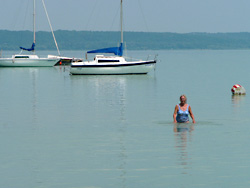 Hungary was a country new to us, and on this trip we spent the best part of a month here, split into two parts, which shows how much we enjoyed it. We spent a while circumnavigating Lake Balaton, the biggest lake in Europe outside Scandinavia, and by this time (in better weather) a major target for holidaying Hungarians. The city of Pecs is a lovely place, as is Szeged,
Hungary was a country new to us, and on this trip we spent the best part of a month here, split into two parts, which shows how much we enjoyed it. We spent a while circumnavigating Lake Balaton, the biggest lake in Europe outside Scandinavia, and by this time (in better weather) a major target for holidaying Hungarians. The city of Pecs is a lovely place, as is Szeged, 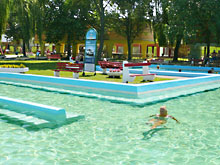 where we camped on the bank of the Danube looking across to the city. The (large, grassy, very quiet and peaceful) camping ground is part of a spa area, with shallow swimming pools at a bath-like temperature of 25 to 35 degrees, a new experience for us and very pleasant.
where we camped on the bank of the Danube looking across to the city. The (large, grassy, very quiet and peaceful) camping ground is part of a spa area, with shallow swimming pools at a bath-like temperature of 25 to 35 degrees, a new experience for us and very pleasant.
We drove through from there into Romania, with which we did not get on so well. The road surfaces were appalling and the driving maniacal, so that Michael was very unusually stressed behind the wheel. This came to a head when we were struck a glancing blow by a young woman in a Polo – very little damage to us, and she was very apologetic, but that was quite enough and after four days or so we returned to Hungary. It did amaze us that Romania is now in the EU.
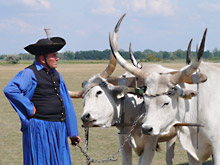 We enjoyed the famous Hungarian “Great Plains”, with a wonderful wildlife rehabilitation centre, acrobatic horsemen and unique farm animals, but by plains standard it wasn’t up to the Hay Plains! Tracked west through more spa country, the waters being very popular for their “preventative” powers, as described (exactly as written here) in a campsite brochure: “The man value . . . is the alkali-hidrogenkarbonate thermal and mineral water. . . Its chemical and heating effects may be very useful for chronic locomotor disporders, rheumatological diseases, the degradation of verteleral disk. Its good int he case of some neurological diseases which have symtoms as muscular dystrophy of plegiachromic gynaecological diseases”. No wonder we were feeling good. The wine of the area was good, too. Eger castle is famous as the place where a well-outnumbered garrison of soldiers and women successfully defended against a Turkish siege in 1552. According to legend, their bravery was assisted by the local red, which became known as “Bull’s Blood” (Egri Bikaver) because the Turks thought that was what they were drinking.
We enjoyed the famous Hungarian “Great Plains”, with a wonderful wildlife rehabilitation centre, acrobatic horsemen and unique farm animals, but by plains standard it wasn’t up to the Hay Plains! Tracked west through more spa country, the waters being very popular for their “preventative” powers, as described (exactly as written here) in a campsite brochure: “The man value . . . is the alkali-hidrogenkarbonate thermal and mineral water. . . Its chemical and heating effects may be very useful for chronic locomotor disporders, rheumatological diseases, the degradation of verteleral disk. Its good int he case of some neurological diseases which have symtoms as muscular dystrophy of plegiachromic gynaecological diseases”. No wonder we were feeling good. The wine of the area was good, too. Eger castle is famous as the place where a well-outnumbered garrison of soldiers and women successfully defended against a Turkish siege in 1552. According to legend, their bravery was assisted by the local red, which became known as “Bull’s Blood” (Egri Bikaver) because the Turks thought that was what they were drinking.
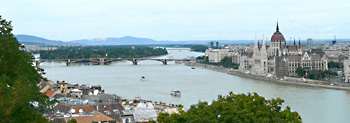 We spent several days in Budapest, of course, camped in a convenient but chaotic site an easy bus and rattly metro ride from the city. Far too few power points serviced a mass of campers, so that multipoint plugs piled upon multi-point plugs, radiating wires like a mutant octopus . . . we escaped electrocution, even in a violent thunderstorm. There are unforeseen hazards to this way of life.
We spent several days in Budapest, of course, camped in a convenient but chaotic site an easy bus and rattly metro ride from the city. Far too few power points serviced a mass of campers, so that multipoint plugs piled upon multi-point plugs, radiating wires like a mutant octopus . . . we escaped electrocution, even in a violent thunderstorm. There are unforeseen hazards to this way of life.
There’s lots to see and do in this major European city, and we enjoyed the magnificent Museum of Fine Arts, with a visiting exhibition of Turner’s Italian works, and a concert by the Solti Chamber Orchestra at St Stephen’s cathedral. 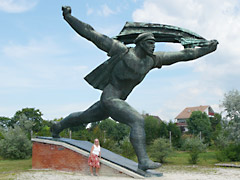 Over the days we walked both Buda and Pest, on opposite sides of the Danube, with several spectacular buildings and views and an attractive old town. The city is marred by rubbish and graffiti and the sad sight of aged beggars and homeless people, but this is not typical of Hungary as a whole.
Over the days we walked both Buda and Pest, on opposite sides of the Danube, with several spectacular buildings and views and an attractive old town. The city is marred by rubbish and graffiti and the sad sight of aged beggars and homeless people, but this is not typical of Hungary as a whole.
Most of the nations once under Soviet domination are shedding all signs of that unhappy era, but a few kilometres outside the city there is the very quiet Statue Park, an extraordinary collection of Soviet-era sculpture that was saved from the customary destruction when the era collapsed and were brought together as a display. Well laid out and presented, the massive statues include Marx, Engels and Lenin as well as the typically triumphal flag-bearers of Socialism. All that remains of a gigantic statue of Stalin is his boots.
Back then into Austria, via a lovely run following the fast-flowing Danube. We called in at Eisenstadt and the Haydn museum in the Schloss Esterhazy, where the composer did so much work and where there is a 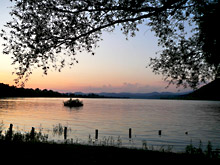 glorious and reputedly acoustically perfect concert hall built by the family for him. A marvellous curiosity at the museum was the baryton, a kind of double-stringed cello much favoured by Haydn, and we bought a CD of the music he composed for it. A short run then to Vienna and a pleasant site where Norma had to stay for a few days on her own while Michael flew to Indianapolis to give a keynote address at a motor sport safety conference.
glorious and reputedly acoustically perfect concert hall built by the family for him. A marvellous curiosity at the museum was the baryton, a kind of double-stringed cello much favoured by Haydn, and we bought a CD of the music he composed for it. A short run then to Vienna and a pleasant site where Norma had to stay for a few days on her own while Michael flew to Indianapolis to give a keynote address at a motor sport safety conference.
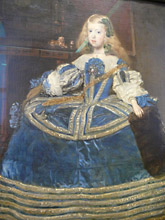 It’s hardly necessary to review the glories of Vienna, and we walked the city from end to end. Memorable were the Kunsthistorisches Museum, with its fabulous assembly of art collected by the Habsburg dynasty over the generations, an amazing collection of historic musical instruments in the Hofburg, and the lovely state carriages at the Schonbrunn Palace.
It’s hardly necessary to review the glories of Vienna, and we walked the city from end to end. Memorable were the Kunsthistorisches Museum, with its fabulous assembly of art collected by the Habsburg dynasty over the generations, an amazing collection of historic musical instruments in the Hofburg, and the lovely state carriages at the Schonbrunn Palace.
More driving along the Danube, then, generally west along the hilly southern “right” bank of the river, flanked by several castles and palaces reaching for the sky. 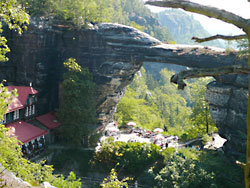 This took us to the Czech Republic, another country new to us, with idyllic countryside punctuated by medieval towns such as Cesky Krumlov. Lots more Bohemian castles, of course, and some fascinating walks through terrain such as the Teplice Rocks, gorges left by the erosion of sandstone rocks. More impressive walks were in the Ceske Svycarsko national park, with a huge sandstone bridge, and down into the Kamenice Gorge for a fun ride in a punt.
This took us to the Czech Republic, another country new to us, with idyllic countryside punctuated by medieval towns such as Cesky Krumlov. Lots more Bohemian castles, of course, and some fascinating walks through terrain such as the Teplice Rocks, gorges left by the erosion of sandstone rocks. More impressive walks were in the Ceske Svycarsko national park, with a huge sandstone bridge, and down into the Kamenice Gorge for a fun ride in a punt.
In northern Austria we had visited the notorious Mauthausen Lager, a work (slave labour) camp, where the starving inmates were expected to carry huge rocks from its quarry up 200 stairs – the “death steps” – up to the camp. 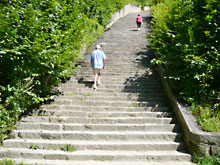 Some simply jumped to their deaths from the quarry cliff rather than continue with this ordeal or face the small gas chamber used for recalcitrants. In the Czech Republic we visited Terezin, previously Theresienstadt, a ghetto used as a staging post for the extermination and work camps but where the town was dolled up as a “happy” camp for the Jews when visited by humanitarian organisations.
Some simply jumped to their deaths from the quarry cliff rather than continue with this ordeal or face the small gas chamber used for recalcitrants. In the Czech Republic we visited Terezin, previously Theresienstadt, a ghetto used as a staging post for the extermination and work camps but where the town was dolled up as a “happy” camp for the Jews when visited by humanitarian organisations. 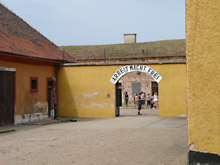 These places are now most respectfully maintained as places for recollection and reflection on the potential for man’s inhumanity to man, and like so many of such places, they ironically tend to be set among sylvan countryside and the sound of birds flying free.
These places are now most respectfully maintained as places for recollection and reflection on the potential for man’s inhumanity to man, and like so many of such places, they ironically tend to be set among sylvan countryside and the sound of birds flying free.
Finally in the Czech Republic, having looped around almost the entire perimeter of the country, we visited the amazing spa town of Karlovy Vary, where devotees of “the waters” fill their teapot-like drinking vessels with hot mineralised water from the several hydrants fed by the springs. The sulphurous taste of the water is supposed to be countered by a fiery liqueur, which was clearly most popular. Signs on the buildings suggested several other therapies and a walk-in endoscopy, but we declined these invitations.
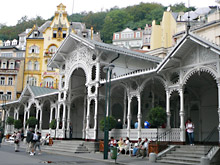 With time running out we were through Germany in three days, but two of these we spent parked on a grassy disused wharf on the bank of the Rhine, right at the most spectacular spot under the Loreley escarpment. The constant flow of vessels on the river was an absorbing sight: huge barges, virtually small ships, carrying heavy loads of containers; deeply laden bulk carriers; cruise ships and smaller local cruise boats; and a few small recreational craft, all of them struggling against the stream round the Loreley bend.
With time running out we were through Germany in three days, but two of these we spent parked on a grassy disused wharf on the bank of the Rhine, right at the most spectacular spot under the Loreley escarpment. The constant flow of vessels on the river was an absorbing sight: huge barges, virtually small ships, carrying heavy loads of containers; deeply laden bulk carriers; cruise ships and smaller local cruise boats; and a few small recreational craft, all of them struggling against the stream round the Loreley bend.
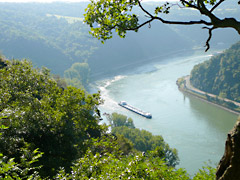 Back in Calais we waited overnight in the car park for the cheap ferry leaving in the early hours, and by late August we were back in England. We had the usual fun catching up with much-loved relatives, and this time also enjoyed catching up with a fellow medical student from Cambridge days, who has a fascinating turkey farm near Michael’s sister Kate.
Back in Calais we waited overnight in the car park for the cheap ferry leaving in the early hours, and by late August we were back in England. We had the usual fun catching up with much-loved relatives, and this time also enjoyed catching up with a fellow medical student from Cambridge days, who has a fascinating turkey farm near Michael’s sister Kate.
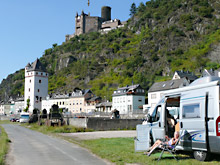 We also spent a few days in London, camped at Crystal Palace, and after most of a lifetime away from the city we visited several old haunts and enjoyed new thrills such as a Shakespeare play at the Globe theatre. More museums were enjoyed, of course, including the Greenwich Maritime Museum (which could do with a few ships) and the supreme – and free – National Gallery in Trafalgar Square. visiting a few more castles and historic monuments, along with the falling pound against the dollar, has made us think that next year we will spend a lot more time in the British Isles, as there is so much to see and do there.
We also spent a few days in London, camped at Crystal Palace, and after most of a lifetime away from the city we visited several old haunts and enjoyed new thrills such as a Shakespeare play at the Globe theatre. More museums were enjoyed, of course, including the Greenwich Maritime Museum (which could do with a few ships) and the supreme – and free – National Gallery in Trafalgar Square. visiting a few more castles and historic monuments, along with the falling pound against the dollar, has made us think that next year we will spend a lot more time in the British Isles, as there is so much to see and do there.
We were finally pleased to be home in Sydney, the house had been beautifully cared for by our house-sitters, and the dog was healthy and happy. We settled back in to work on various projects, Norma’s native bird and animal rehab work and Michael’s continuing work on motor sport safety. He did, however, renege on a two-year-old decision, and went motor racing again. Plus ça change, plus c’êst la meme chose . . .
